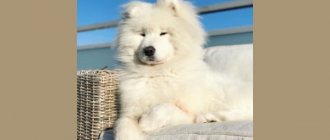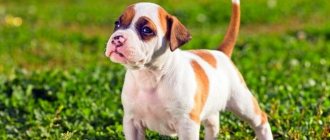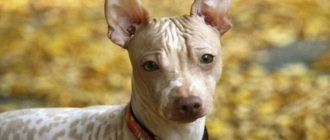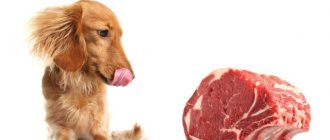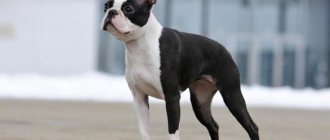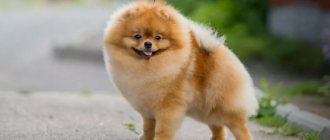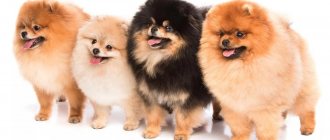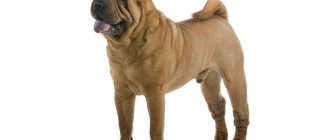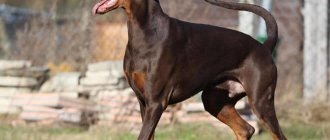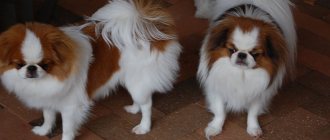Many people think that Spitz dogs are one dog breed that has become especially popular recently. We are talking about Pomeranians - cute small plush dogs. However, Spitz dogs are a whole group according to the ICF classification. Within this group you can find not only decorative dogs, but also sled dogs, hunting dogs, and herding dogs. An amazing fact, but almost all dogs of the Laika breed belong to the Spitz group. From the article you will learn everything about Spitz - we will tell you about the character of each breed from this group and its characteristics, details of care and nutrition. Based on this information, you can choose a pet of the breed group.
History of the breed
Mention of dogs that can be considered the ancestors of the Spitz can be found in different countries. According to one version, dogs were used for hunting and herding livestock back in the 4th century BC. e. Dogs with similar external characteristics could be seen in many historical monuments - paintings, engravings.
Note that the ancestors of the Spitz were large dogs and weighed about 30 kg. They looked like wolves, and their coat color was white, beige or black. However, the formation of the breed is associated with the European continent. In particular, with Germany. For a long time, dogs were used for protection and heavy labor. Over time, representatives of the nobility drew attention to them and forbade ordinary people from owning and breeding dogs of this breed.
The story of Spitz dogs began as regulars in rich houses and favorites of rich ladies. Selection work was carried out to reduce the size of the dog. Thus, Germany gave rise to a new line of Spitz dogs, which were called German. The fashion for dog breeds moved to England. Since the Victorian era, exhibitions began to be held, to which individuals over 7 kg were not allowed.
Interesting fact: in the century before last, women predominated among Spitz breeders. It was they who initiated the creation of nurseries for decorative dogs of this breed.
Distant ancestors
The Spitz is the oldest dog breed in Europe. The beginning of the development of the breed dates back to the times of Ancient Rome and Ancient Greece. Silhouettes of Spitz-like dogs were discovered on utensils and interior decoration in the early 10th century BC. In the Middle Ages, the breed began to develop as “ladies' dogs.” The hounds selected small individuals from among peasant dogs and crossed them with each other. As a result, small dogs appeared with a mischievous character and a very attractive appearance.
As a result of selection, small dogs with a mischievous character appeared
Germany is considered to be the birthplace of the breed, but this is not true. The first breeders worked in Finland, Holland and Denmark. In those distant times, Spitz-like huskies began to be bred on the territory of Northern European countries. The working characteristics and easy adaptation of animals to different weather conditions allowed people to use dogs for various types of assistance to people: guarding the yard, moving small loads, catching rats on ships and small barges. Active and hardy dogs easily coped with this work. Loyalty to one owner and distrust of strangers remain in the character of these dogs in our time.
Spitz means “sharp” in German. The sharp, recognizable muzzle or the sharp and quick mind implied by the first owners remains a mystery. Both of these concepts are true for these smart animals.
The first “ladies'” and decorative dogs were Spitz dogs. A.P. Chekhov described the Spitz in his work “The Lady with the Dog”. The animals also had a security function: barking at a stranger could wake up the servants and alarm the whole house, and their small size made it possible to take the pet on a long journey. Dogs are very attached to their owner and get bored when separated for a long time. The dog's devotion and magnificent fur coat captivate owners even today.
Photo of a German dwarf puppy
What does a Spitz look like - general features, description
Despite the fact that the breed group includes dogs that are strikingly different in size, habits and colors, their appearance can be described by a number of characteristic features:
- small head. If you look at it from above, the head may seem too wide. A front view will show that it is tapered and proportional to the dog's body;
- the nose is slightly flattened. At the same time, it is small and neat. Color - black or dark brown;
- lips are dry. They fit tightly to the gums and have no folds;
- eyes are round. They appear small against the background of the narrowed muzzle;
- The ears are neat, house-shaped. They stand and are always directed straight up;
- shortened neck;
- back of medium length;
- colors - black, white, red or brown. Marks and spots on Spitz dogs are strictly limited to the specific breed;
- scissor bite;
- The standard for a dog's coat imposes strict requirements - straight without curls. The undercoat is straight and dense, it can be either short or long. The coat of a dog from the Spitz group should seem to stand up, giving the impression of a fur ball, and be thick.
Interesting: disqualifying signs include malocclusion, ungrown crown, deformed eyelids (eversion or inversion), semi-erect ears, bright white spots in color.
Regarding the nature of the breed group, all dogs have one quality that can cause problems for the owner. A dog of any size feels like a giant, capable of defeating any enemy. They often bully dogs three times their size and do not yield even in a fight.
Grossspitz (large German)
A very rare breed, the largest in the German Spitz family (different standards define it either as a separate breed or as a subspecies of the German Spitz) . Grossspitz grow up to 45 cm. Dog handlers believe that these dogs appeared earlier than other dogs from the group. They were bred in northern Germany, England and France as herding dogs.
Like all Spitz, Gross is a square, fluffy fox with long hair of red, brown or black color, fluffy feathers on the chest, body, and tail.
The animals are very smart, but naughty. They do not know how to concentrate for a long time and sit quietly, they need to constantly move. The breed has an easy-going character; the dogs get along with children, but do not like strangers and can serve as guards. The average cost is 25-40 thousand rubles.
What types of Spitz are there and how do they differ?
Spitz dogs can be divided into groups according to a variety of criteria. For example, hunting, draft, decorative and security. But the greatest interest for future owners is the division of dogs of this breed by size. If you are choosing a dog to live in an apartment, you should hardly pay attention to large individuals with a developed sense of security and territory. Such a dog will simply get bored at home and quickly become depressed.
We propose to divide Spitz into varieties:
- dwarf or miniature - their height at the withers does not exceed 20 cm;
- small - from 20 to 29 cm;
- medium - from 30 to 39 cm;
- large - from 40 to 50 cm;
- large - from 42 to 55 cm.
Despite the common standard features, all Spitz dogs have their own character traits, pros and cons of keeping them. Let's talk about them in more detail.
Tiny
From the name it becomes clear that such a dog will look more like a toy. Mini-Spitz grow no more than 22 cm at the withers. These are small teddy bears that will become excellent companions and will be ready to accompany their owner everywhere. These dogs cannot stand loneliness; they need constant contact with a person.
Pomeranian (dwarf) Spitz
The weight of the orange does not exceed 3-4 kg. Despite the decorative nature of such a dog, it needs active games. This is not a couch dog who will sleep all the time. The Pomeranian has inherited the character of his ancestors and during a walk he will boldly bully not only animals of equal size, but also larger individuals.
Babies come in cream, white, and red. There are two types:
- bearish;
- fox
Dogs get along well with other pets, but require a lot of attention. If it is not enough, they may become jealous and express dissatisfaction with hooligan antics. They love to bark loudly, notifying the owner of all interesting changes in the environment.
Cost - from 45 to 150 thousand rubles. Depends on the rarity of the animal’s color and exhibition prospects.
Small
The group includes representatives of the breed that do not grow more than 30 cm at the withers. Another name for such dogs is Kleinspitz. By the way, this group also includes standard Pomeranians, whose height reaches 28 cm. The weight of small representatives of the Spitz varies between 8-10 kg. But for an orange, this figure should not exceed 6 kg.
The life expectancy of small Spitz dogs is quite long - from 15 to 18 years. This is explained by good health and the absence of a large list of breed diseases. The quality of life of such a pet depends on the owner’s ability to provide him with active walks and constant intellectual activity. Dogs learn quickly and love the process of learning new commands.
However, Kleinspitz dogs have a unique character and may not get along with every family member. But others treat their four-legged pets calmly and friendly.
German Spitz
One of the most popular breeds in the group (weight no more than 10 kg). The life expectancy of a German is from 13 to 17 years. The standard provides color options:
- cream;
- grey;
- brown;
- carbonic;
- bright white.
Externally, dogs resemble a square. The tail is perkyly wrapped in a donut. The areas on the neck, chest and tail have longer hair.
His small size does not prevent the German from being an excellent defender and danger signaler. These dogs love a family that includes other animals. They are friendly and tireless in games and fun. Well trained, but require a firm hand. Otherwise, they may grow up stubborn and disobedient.
Cost: from 25 to 80 thousand rubles.
Volpino Italiano
Volpino (translated from Italian as “fox”) belongs to the group of small Spitz dogs, since its weight does not exceed 5 kg and its height is 30 cm. Another name for the breed is Florentine or Palace. Initially, Volpino could be seen on the streets of Florence, when they accompanied trade convoys with their ringing bark. Then the snow-white dogs moved and firmly settled in the palace chambers of the nobility.
Acceptable Volpino colors:
- bright white;
- beige;
- ginger.
The bark of this dog is in no way comparable to its miniature size. It is so loud and strong that a better guard against uninvited guests could hardly be found.
The cost of dogs of this breed reaches 90,000 rubles.
American
The American line of Eskimo Spitz has several branches that differ in size:
- toy - from 23 to 29 cm at the withers;
- mini - no more than 38 cm;
- standard - grows up to 48 cm.
The rarest and most expensive representative of the breed is considered to be of the “toy” type. Its weight does not exceed 4 kg. Eskimo representatives of the dog group do not have an approved standard; their description is based on criteria common to all Spitz dogs. It is believed that individuals of the Samoyed Laika were used in the breeding work. The smallest representatives of the American branch are used as companions. Larger animals successfully serve as guards and shepherds among the indigenous population of Alaska.
The breed is not recognized internationally, only by the US National Federation. The dog will be an excellent option for a family who wants to have their first pet. He will not only be an excellent playmate for children, but also an excellent guard. Eskies (as the dog is called in its homeland) have a very developed sense of territory and distrust of strangers.
Cost - about 60,000 rubles. It is worth understanding that the dog will not have documents that are recognized by the FCI.
Average
This category includes dogs whose weight can reach 17-20 kg and height 38-40 cm. The future owner should think twice before getting a fairly large Spitz. If you do not plan long walks with active games, such a dog is unlikely to suit you. A dog of this breed, constantly sitting at home alone, will demonstrate behavior that is similar in destructive power to a hurricane. This does not mean that the breed is characterized by bad behavior, it is just a natural reaction to boredom and accumulated energy.
Mittelspitz
The “medium” Spitz has a fairly compact size - height up to 36 cm, and weight up to 15 kg. The definition of average refers only to the size of the dog of this breed, its mental abilities are at the highest level. Dogs are playful and loyal. Among the representatives of the breed you will not find an aggressive or embittered dog. But gaps in training can turn a dog into a stubborn and unyielding dog.
They love children and get along well with other pets. It's better if they grow up together.
The average price is 40,000 rubles.
Japanese
Interestingly, this breed is recognized by all cynological federations of the world. The exception is American. The USA considered that Japanese dogs were very similar to mini-line Eskimo Spitz dogs, so they refused official recognition. The Japanese have snow-white fur, pointed ears and a pointed muzzle.
The homeland of the Japanese variety is Tokyo. Breeders bred the breed using individuals of exclusively snow-white shades.
A feature of the breed is considered to be pathological sensitivity. This does not mean that the dog will show aggression in response to an insult. But he is able to show the owner that he is very upset by his behavior and will punish him with a long period of “silence”. This dog is suitable for families with children who need an additional protector of the territory. The dog will not let strangers through, will not show aggression in response to children's pranks, but will simply walk away.
The average price is from 30 to 70 thousand rubles.
Large
The future owner of a Spitz should understand that the larger the representative of the breed, the more difficult it will be with him. Such dogs are suitable for living in a private home; their thick coat allows them to live in a spacious, insulated enclosure. Among the representatives of large Spitz dogs you can find dogs that will become excellent guards or share with a person his passion for hunting.
Grossspitz
A powerful dog with a height at the withers of about 45 cm, developed intelligence, and a sense of territory. A distinctive character trait is a pathological reluctance to obey. The breed was bred by French, German and English farmers as an assistant in grazing livestock. This is what explains the animal’s autonomy and independence. It is capable of making decisions on its own.
Standard colors of Grossies:
- black;
- white;
- brown.
Properly raised from childhood, the Grossspitz is distinguished by an easy-going character, respect for even the smallest family members and playfulness. If you are not ready to work with the puppy from the very first days, walking the dog for at least 40 minutes three times a day, this breed is not for you. Grosses feel very bad in the cramped conditions of a small apartment.
Average price of a puppy: from 25 to 60 thousand rubles.
Finnish
The breed has a complicated history. The reason is that selection was carried out simultaneously in two countries (Finland and Russia). The result was the emergence of two lines of dogs in one breed group. They differ slightly in appearance and character.
The Finnish Spitz is a classic hunting dog. With it, the future owner will be able to hunt bears, fur-bearing animals, upland game and rodents. Dense coat with a thick undercoat allows Finnish dogs to live in outdoor conditions. A private house is suitable for her, but not an apartment. In an urban environment, a dog will quickly get bored. She needs frequent walks, and not rare trips “every once in a while.”
The peculiarity of dogs of this breed is:
- fiery red fur (or red), most similar to a fox;
- arrogant character, which is expressed in ignoring the owner’s commands and frequent escapes.
Cost: within 50,000 rubles.
Large
These are dogs that often outgrow 50 cm at the withers, and their weight can reach 45 kg. It is worth understanding that only an experienced owner can handle such an animal. You should not get a large Spitz as your first pet and trust children under 14 years of age to walk it.
Wolfspitz (Keeshond)
Wolf Spitz owe their appearance to the Netherlands. At a certain period of time, dogs had a different name - “barge dogs”. It appeared because of the designation of the type of activity for which wolves were used - protecting barges from hordes of rats and mice. One of the largest Spitz dogs - weight up to 30 kg, height up to 50 cm.
The dog received its modern name because of its unusual color - black and gray hairs alternate in the general mass, and light “glasses” clearly stand out on the eyes. Dogs are very attached to all family members, especially children. They are able to tolerate not very neat games of younger family members.
They need long walks, active exercises, and constant games. Thick, fluffy coat requires careful grooming - combing.
Average price: 50,000 rubles.
Karelian bear husky
A large dog, reaching 57 cm at the withers. This is the only smooth-haired representative of the breed group. The main color of huskies is black. There are often white spots and tan marks. They are classic hunters, ideal for hunting large game. A character trait is the adoration of a single owner. Only with him the dog will go hunting and work effectively. Distrust of strangers does not allow the dog to go hunting with other people.
Before getting such a dog, you need to understand for what purpose the pet is being purchased and whether it will have to be housed later if it is not physically busy enough and gets bored at home.
Average cost: 60,000 rubles.
Eurasian
The Eurasier is both a Chow Chow and a Wolfspitz. This should not be surprising - after all, these are the breeds that participated in the selection. The height of males at the withers can reach 60 cm, for females the standard is lower - up to 56 cm. The color of the Eurasier can be any, with the exception of white. It’s interesting, but you can’t tell a puppy exactly what color his coat will be when he grows up. After shedding and the puppy fluff falls out, the shade will change. It will either be darker or lighter.
Despite their enormous size (males can weigh up to 55 kg), the dogs are distinguished by their flexible disposition, obedience and adore their owner. They are loyal to children and small pets. Even if you live in a private house, you should not place your dog in an enclosure. Such a life is not for him, he will consider himself abandoned and will quickly fall into depression. He needs constant visual contact with a person.
The average cost of a puppy is from 80 to 150 thousand rubles.
Samoyed dog
An indigenous breed of the Russian North and Siberia. Shaggy dogs were bred by Samoyed tribes. Animals transported cargo, slept in dwellings, warming people with their warmth.
The Samoyed dog is often called the Arctic Spitz.
Compact, elegant Samoyeds grow up to 50–60 cm. Their coat is truly “polar”: thick, dense, shiny, snow-white or cream in color. The structure and location of the eyes, slightly raised corners of the lips make the expression of the muzzle friendly, smiling and good-natured.
Samoyed smile.
The character of Samoyeds is open and friendly. They love to communicate, “talk,” conveying a lot of emotions with their voices. Due to their too good-natured attitude towards people, they will not become good watchmen and security guards.
How to choose a puppy
Before choosing a Spitz puppy, you need to decide whether such a dog is suitable for you in terms of temperament, size and character traits. When choosing a baby of this breed group, it is worth considering:
- Animals with a very calm character are rarely found in the group. You will understand this if you watch the puppies. They are in constant motion, bullying other babies in the litter;
- where are you planning to buy? It is recommended to contact only nurseries registered in the RKF. Many breeds (for example, Eurasier) are considered rare and unscrupulous breeders pass off representatives of other breeds or mongrels as them;
- age of the baby - the optimal age is 2.5-3 months. The breeder is already carrying out the first vaccination and testing for breed pathologies. He is ready to tell you about the character and characteristics of the baby;
- parents' data. This aspect is especially important if you want to take a working dog into your home. Her working qualities often depend on similar parental characteristics.
Genetic pathologies
This extremely unpleasant block of diseases includes problems with the thyroid gland, adrenal glands, epilepsy, and umbilical hernia. Another unpleasant “genetic gift” can be black skin disease. It provokes hair loss over large areas of the body with blackening of the skin in these places.
Improper care of your pet becomes, in most cases, almost the main cause of emerging health problems. Untimely vaccinations, treatments against parasites, etc., for everything that the owner did not have time to do or forgot to do - the baby pays.
This thesis can also be applied to proper nutrition. Failure to maintain the optimal balance when forming a diet, introducing non-recommended sweets causes itching, allergies, and indigestion. And excess weight, along with a sedentary lifestyle, negatively affects both the functioning of internal organs and the functioning of joints and muscles.
We must not forget about hygiene. Ears, eyes, and teeth must receive daily preventative care.
Haircut for Spitz
Advantages and disadvantages
Each individual breed has its own advantages and disadvantages, but universal ones can be identified for the entire group.
| pros | Minuses |
|
|
Height
Like all small representatives of “human friends,” the weak point of the Spitz is the joints and bones, which may not withstand its activity, especially if it is overweight. In this regard, one of the main dangers is injury (dislocations, dysplasia, etc.).
Simply observing the pet's movement will help the owner identify the problem. If the baby limps when walking, jumps, gets tired quickly during a walk, or cannot run at all, these are signs of problems with the musculoskeletal system or injuries.
It is possible to reduce the likelihood of such diseases with the help of proper nutrition, strengthening muscles, weight control, and the temporary introduction of additional vitamins and supplements. To prevent the occurrence of such problems, starting from the early stages of life, do not allow your pet to jump from high surfaces or run down stairs on its own.
Owner reviews
On the Internet you can find both positive and negative reviews from Spitz owners. If you look at it, the negative experience of ownership is based on the unpreparedness of the future owner to raise and communicate with a temperamental dog.
Irina S. I didn’t even know there were so many Spitz dogs! I thought it was a Pomeranian plush miracle, German and that’s it. But it turned out there was a whole group of them. I learned this when we were looking for a hunting dog for my husband. We bought a Finnish one. What a redhead he is - it even blinds your eyes when he runs through the white snow. But the character is complex. She loves her husband immensely. The rest, it seems to me, he simply respects as members of his family. We live in a private house, the dog walks and exercises a lot. This is a must.
Maxim O. Gave his wife a Pomeranian. I thought that “bear cub” was an affectionate nickname. And this is the type of dog. It seemed like I had come to a toy store - the puppies seemed unreal. I thought the dog would only be for his wife, but he became attached to the little one. Very smart, protective.
Oleg R. I have a Wolfspitz. Really looks like a wolf and has the same stern disposition. The first dog of this type, so he made a lot of mistakes. Since childhood, I treated him like a funny fluffy bear and allowed me a lot. I grew up and problems began. He is not evil, but stubborn. If he doesn't want to, he won't do it. We went to dog trainers and corrected all the flaws in our upbringing. What can I say - any dog needs training. This is a living creature, it wants to walk, eat tasty food and communicate with people.
Where can I buy
The breed is popular in Russia; in many cities there are nurseries that breed Spitz dogs. Among them are:
- Liebe Kinder (Ekaterinburg);
- Fire Fox (Kaluga);
- Mini Gum (Moscow);
- Bon Chanterelle (St. Petersburg).
The price of puppies may vary depending on the class of the pet. On average, a Pomeranian with all documents will cost 25,000 rubles. If you plan to purchase a show-class dog, the cost can rise to 100,000 rubles.
Whatever type of Spitz you like, you should remember that the dog’s behavior is primarily determined by upbringing and training. Therefore, any variety of the breed can become an excellent friend or family companion.
Interesting Facts
Interesting Facts:
- one of the legends says that dogs of this breed accompanied the wise men who came to worship the newborn Christ;
- dogs are so clean that they can wash themselves like cats;
- Spitz rose very quickly “from rags to riches” - in about 100 years;
- I. Newton had a pet Pomeranian Spitz. Legend has it that one day a playful dog knocked over a candle on valuable manuscripts and they were destroyed. But he was loved and therefore forgiven by the owner;
- of the 20 animals that set sail on the Titanic, only 3 survived. And two of them were Spitz dogs;
- Loud barking from dogs is not harmful. The need to loudly warn of danger is genetic. After all, it was with this activity that the history of the breed began.
Color options for the bear-type Pomeranian
White Pomeranian Spitz Bear
This dwarf bear-type Pomeranian is considered the most expensive subspecies. They brought him out in Japan. They should not be confused with albinos. The puppies of this Pomeranian have a special recessive gene that prevents their fur from coloring, but the snow-white pets have dark skin and claws.
Brown (chocolate)
The bear-type Pomeranian, which has a brown coloring, is also rare. A dog of this color looks like a real brown bear cub. The standard includes a dark chocolate coat without any spots.
Sable shade
This is a fairly common color, consisting of gray and reddish shades. Zoologists claim that it is correct to call this coloring “zonal” and divide it into several types.
Red shade
Red bear-type Pomeranians are the most numerous and popular species. With this coloring, some parts (for example, ears, “pants” or tail) have lighter orange shades than the main body of the body.
Black bear type Pomeranian
Classic antique coloring is now very, very rare. This is due to the fact that to breed a truly black Miniature Spitz, you only need the same representatives in its family, so today’s “charcoal” Pomeranian bears have patches of light shades in their coats.
Cream Pomeranian bear type
This shade has many variations: from snow-white to sand. Therefore, true cream Pomeranians of the bear type are very difficult to recognize among the small “fluffies” of snow-white or orange color.
Other
There is another type of color for the bear-type Pomeranian Spitz - gray, or in other words silver. At birth, such babies have a “charcoal” fur color, and later it thickens and brightens.
Breeds similar to Spitz
There are a number of breeds that have participated in the selection of new types or are simply similar to Spitz.
Schipperke
Externally, the Schipperke is very similar to the German Spitz. This breed is playful, friendly and intelligent. It is characterized by a black color, pointed ears and round beady eyes, but it belongs to the group of shepherd dogs.
Alaskan Klee Kai
The breed was the result of a desire to breed a decorative copy of the husky. In the Toy variety, Klee Kais can rival Pomeranians with their thick, padded coats. They are exceptionally cute, and their blue piercing eyes look straight into the heart of the owner. From the husky they inherited a difficult character, a passion for dominance, disobedience and a desire to escape.
Chow chow
The dog breed is related in origin to the Shiba Inu. The animals look like a greatly enlarged copy of the orange. The same thick, dense coat of bright color, erect ears, which, due to the abundance of fur, seem slightly rounded. The dog's character is docile and calm. She doesn't need as much intense play as a Pomeranian. But the toy appearance should not be misleading - this is a serious breed of dog. They are able to protect their owner and love to dominate. You need to be careful while walking.
Small German
Kleinspitz is the very first, most standard German Spitz, from which the Mittel, Gross and Mini branches came.
It is this breed that guarantees the standard: a fox face, a wedge-shaped head, a squat body of a square format, abundant coarse hair around the body, neck and tail, moderately long limbs. Dogs appeared in Germany, judging by excavations, back in the Stone Age. Now the price for puppies has dropped – 25-35 thousand rubles.
This is a truly decorative sociable dog with a perky disposition. She is ideal for the conditions of a city apartment, because she grows no more than 30 cm. The Kleins' main problem is restlessness. The dogs are lively, active, affectionate, loyal, not evil. They need company, a kind owner and lots of goodies.
Briefly about the main thing
- Spitz are a broad group of dogs that include a wide variety of breeds. They differ in size and color.
- The entire group is characterized by common external signs and temperamental characteristics.
- All representatives need a strong owner and training from puppyhood.
- They have good health and a stable psyche.
- Suitable for families with children and other animals.
- All Spitz dogs - from the smallest to the giants - need long walks and physical activity.
Which Spitz do you like? Why? Tell us about your pet and its character, please.
Swedish Lapphund
Scandinavian dog with the appearance of a typical Spitz. The animals were bred by the indigenous people of Northern Europe, the Sami or Laplanders.
The second name for the Swedish Lapphund is Lapland Spitz.
Height at the withers is 40 - 50 cm. The only color is solid black, less often with brown inclusions. Initially, Swedish Lapphunds helped hunters and reindeer herders. Modern Lapland Spitz are excellent family dogs and universal companions.
Difficulties of breeding
Breeding bear-type pets is a rather difficult and time-consuming task. The fact is that girls endure childbirth hard and often endanger their lives and the lives of their babies. And boys have little interest in reproduction. In addition, in order to obtain ideally purebred offspring, the pet must belong to the breeding class (i.e., have excellent reproductive capabilities and heredity).
And looking after a pregnant female will require regular visits to the veterinarian and a lot of time.
Boy
Male dogs are more independent than females. Therefore, it is very important to start obedience training from a very young age.
They tend to be less capricious and usually more affectionate than females.
One common complaint about male dogs that you hear most often is that dogs like to “mark” their territory and are difficult to toilet train. You should be tolerant and consistent in training your animal.
It is noteworthy that young puppies urinate the same way, regardless of gender. However, after 6 months, most male dogs will raise their leg while urinating, while female dogs will continue to squat.
Such different Pomeranians
In the modern world, Pomeranians are divided into three types:
Adult weight does not exceed 3 kg
- The fox face type is the usual German Dwarf Spitz. The length of the Spitz's muzzle to the size of the head is equal to the proportion of 2:3. The size of the muzzle is 2-3 cm.
- Bear type - the dog's muzzle is shorter, the lower jaw is wider than that of the fox type. The tip of the nose is turned up. The head is round, and the dog has a lot of hair on the cheekbones, which creates the effect of cheeks. The size of the muzzle is 1 cm.
- The doll type is a rare species for Russia. The flat muzzle, large forehead, and low-set eyes make this type of Spitz look like a doll.
Pomeranians have different head shapes that separate the breed, but that is the only difference. Otherwise, mini-dogs are similar in all breed characteristics. The weight of an adult orange is about 3 kg.
The popularity of bear orange is due to its appearance. These cute pets look like a teddy bear, their small size and cheerful disposition captivate people all over the world.
Diet
White Spitz dogs often suffer from allergies. This is due to a paired gene that works with light colors. Hypoallergenic products that will keep you healthy:
- chicken breast;
- rice;
- apples;
- white fish meat;
You need to give up chocolate, strawberries and baked goods.
If you want your dog to be healthy, you will have to follow a certain diet.
Signs of allergies in a dog:
- light nasal discharge;
- redness and peeling of the skin between the fingers;
- clear discharge from the ears;
- redness of the mucous membrane and gums.
If one of these symptoms occurs, the animal should be given a histamine drug for children and taken to a veterinarian.
Shampoos for pets can also cause an allergy attack; you should use shampoos marked hypoallergenic. The Attitudе company produces shampoos for animals with white hair, price 870 rubles. for 900 g
Nicknames
For boy
Popular nicknames for boys:
- Prince.
- Lucky.
- Winston.
- Bentley.
- Luther.
- Little bear.
- Chester.
- Edmund.
- Sid.
- Teri.
- Albert.
- Monty.
- Maximilian.
- Mozart.
- Othello.
- Jupiter.
- Phoenix.
- Bean.
- Toby.
- Bertie.
- Callie.
For girl
Popular nicknames for girls:
- Izzy.
- Princess.
- Lei.
- Bella.
- Roxy.
- Esther.
- Athena.
- Foxy.
- Jessica.
- Janie.
- Gina.
- Massey.
- Mini.
- Marilyn.
- Molly.
- Stella.
- Button.
- Lily.
- Moon.
Girl
Many people have the preconceived idea that a female Pomeranian is superior to a male. However, it is not.
They are difficult to distinguish by appearance. The most obvious sign is the genitals of individuals. Some breeders try to find out the sex of the newborn right away. However, even experienced specialists sometimes confuse the umbilical cord with the male genital organs. Therefore, it is possible to determine the gender correctly only after babies reach 3-4 weeks.
An adult girl is usually a little larger than a boy, but this is all individual.
The main thing to remember is that character and temperament depend solely on the individual. In general, girls are playful, funny, and loyal.
One of the inconvenient moments when keeping females is estrus, which occurs several times a year. At this time, the bitch will attract all the males in the area, which can make walking difficult. The female's first estrus occurs when she reaches the age of 6 to 10 months. You can sterilize her, as unsterilized girls are more bossy and capricious.
